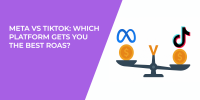Many marketers rush straight into budget decisions when setting up ad campaigns. They ask, “How much should I spend?” or “What’s the right daily budget?” But the real question should come earlier: “Who am I targeting, and why?”
Without a clear targeting strategy, budget planning is just guesswork. You could pour thousands into ads that reach the wrong people. On the other hand, when you define your audience first, even a modest budget can produce meaningful, consistent results.
So, why should targeting strategy come before budget planning — and how can advertisers apply this approach to Facebook Ads and beyond? Let’s break it down.
Why Targeting Is More Important Than Budget
Think of budget as the fuel and targeting as the GPS. A full tank is useless if you’re headed in the wrong direction.
Good targeting ensures that your message reaches the right people, not just the most people. That’s the difference between campaigns that generate vanity metrics — clicks, impressions, likes — and campaigns that actually convert into leads or sales.
If you’ve ever looked at campaign results and wondered, “Why are we getting traffic but no conversions?”, chances are your targeting wasn’t sharp enough. To avoid that trap, many advertisers are now adopting advanced methods such as layered detailed targeting.
What Happens When You Plan Budget First
When advertisers lead with budget, they often:
-
Spread money evenly across campaigns, even if the audiences aren’t well-defined.
-
Overinvest in cold audiences who aren’t ready to convert.
-
Undervalue retargeting, where ROI is usually the highest.
The outcome? Lots of spend, little return.
Budget doesn’t fix poor targeting. It only amplifies it. If you want to understand the bigger shifts driving targeting decisions, you’ll want to stay ahead of Meta’s ongoing targeting updates.
How to Build a Targeting Strategy Before Budget
Before planning budget allocation, you need a clear targeting framework. Ask yourself:
-
Who is my ideal audience? Define segments such as past buyers, cart abandoners, or interest-based cold audiences.
-
What’s their stage in the funnel? Someone who has never heard of your brand needs different ads than someone who visited your site yesterday.
-
What message will resonate? A discount code may work for a warm lead, but cold traffic might respond better to educational or story-driven ads.
When you map audiences this way, budget allocation becomes obvious. For example, you may choose to spend 50% on retargeting, 30% on lookalike audiences, and 20% on broad awareness. If you’re unsure where to start, our guide on custom vs lookalike audiences breaks down the trade-offs.
Real-World Scenario: Targeting First vs. Budget First
Let’s imagine two brands with the same $5,000 advertising budget.
-
Brand A starts with targeting. They identify three segments: recent website visitors, a lookalike audience of past buyers, and an interest-based audience. They allocate most of the spend to retargeting and lookalikes, leaving just a small share for awareness.
-
Brand B starts with budget. They split $5,000 evenly across three campaigns, all with broad targeting.
The results? Brand A sees strong ROI, with conversions from warm audiences. Brand B gets reach and clicks, but very few actual sales.
This simple scenario highlights why targeting always comes before budget. If you’re still debating how to structure budgets later, check out Daily vs Lifetime Budgets for deeper insights.
Tips to Put Targeting Ahead of Budget
If you want campaigns that scale sustainably, try these practices:
-
Test audiences with low spend first. Don’t throw thousands into unproven audiences. Validate them, then scale.
-
Match creative to the funnel. Ads for awareness should educate or entertain. Ads for conversions should push action. For inspiration, review The Ultimate Guide to Facebook Ad Formats.
-
Watch frequency and overlap. Competing with yourself for the same audience wastes money and raises CPMs. See how audience overlap affects performance.
-
Refine continuously. Strong targeting isn’t a one-time setup. Use performance data to adjust and re-prioritize budget.
When you follow these steps, your budget stops being a guessing game and starts becoming a tool for growth. The stronger your targeting, the easier it is to scale with confidence.
Why This Order Maximizes ROI
Targeting strategy provides direction, while budget fuels the journey. When you get the order wrong, you waste both time and money. But when you start with targeting, every dollar works harder.
That’s how marketers consistently achieve better ROI — not by simply spending more, but by spending smarter. For a complete roadmap, see our Facebook Ads Funnel Strategy.
Key Takeaway
Budget planning feels like the big decision. But in reality, it’s step two. Your targeting strategy is step one.
When you know exactly who to reach, where they are in the funnel, and what message will resonate, budget allocation becomes a straightforward decision.
So before asking “How much should I spend?”, ask “Who should I target, and why?” The answer to that question will shape everything else.

